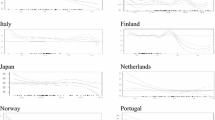Abstract
This paper provides empirical evidence on the dynamics of dual markets in Hungary during the 1980–93 period using cointegration and error correction methodologies. The results suggest that the official and parallel markets were cointegrated. Short-run dynamics of these rates resulted from the overshooting and adjustment by the parallel rate to shocks, without any adjustment by the official rate. A devaluation had no significant impact on the parallel market premium in the long run. Although the premium declined in the short run, it was relatively small and sluggish. One lesson for the design of stabilization programs in other countries is that a devaluation is not a powerful policy tool to reduce the premium effectively.
Similar content being viewed by others
References
Agenor, P. "Stabilization Policies in Developing Countries with a Parallel Market for Foreign Exchange,"International Monetary Fund Staff Papers, 37, 3, 1990, pp. 560–92.
Asea, P. K.; Dueker, M. J. "Non-Monotonic Long Memory Dynamics in Black Market Premia," working paper, Federal Reserve Bank of St. Louis, 1995.
Baghestani, H.; Noer, J. "Cointegration Analysis of the Black Market and Official Exchange Rates in India,"Journal of Macroeconomics, 15, 4, 1993, pp. 709–21.
Barro, R.; Lee, R. "Losers and Winners in Economic Growth," National Bureau of Economic Research Working Paper 4341, 1993.
Bhagwati, J.Autonomy and Consequences of Exchange Control Regimes, Cambridge, MA: Ballinger, 1978.
Booth, G.; Mustafa, C. "Long-Term Dynamics of Black and Official Exchange Rates,"Journal of International Money and Finance, 10, 1991, pp. 392–405.
Charemza, W. "Formation and Dynamics of Foreign Exchange Rates in Eastern and Western Europe," Discussion Papers in European Economic Studies, No. 92/5, University of Leicester, 1992.
Charemza, W.; Ghatak. S. "Demand for Money in Dual-Currency, Quantity-Constrained Economy: Hungary and Poland, 1956–1985,"Economic Journal, 100, 1991, pp. 1159–72.
Edwards, S. "Exchange Controls, Devaluations, and Real Exchange Rates: The Latin American Experience,"Economic Development and Cultural Change, 37, 1989, pp. 457–94.
Engle, R. F. "Autoregressive Conditional Heteroscedasticity with Estimates of the Variance of United Kingdom Inflation,"Econometrica, 55, 2, 1982, pp. 251–76.
Engle, R. F.; Granger, C. W. J. "Cointegration and Error-Correction: Representation, Estimation, and Testing,"Econometrica, 55, 1987, pp. 251–76.
Johansen, S. "Statistical Analysis of Cointegrating Vectors,"Journal of Economic Dynamics and Control, 12, 1988, pp. 231–54.
Johansen, S.; Juselius, K. "Maximum Likelihood Estimation and Inference on Cointegration—With Applications to the Demand for Money,"Oxford Bulletin of Economics and Statistics, 52, 1990, pp. 169–210.
Kamin, S. "Argentina's Experience with Parallel Exchange Markets: 1981–1990,"International Finance Discussion Papers, No. 407, 1991.
__. "Devaluation, Exchange Controls, and Black Markets for Foreign Exchange in Developing Countries,"International Finance Discussion Papers, No. 344, 1988.
Kiguel, M.; O'Connel, S. A. "Parallel Exchange Rates in Developing Countries,"The World Bank Research Observer, 10, 1, 1995, pp. 21–52.
Krzak, M. "The Experience of East European Countries with Different Exchange-Rate Regimes," Research Papers,The Vienna Institute for Comparative Economic Studies (WIW), No. 217, 1995.
Pick, Francis.Pick's Currency Yearbook, New York, NY: Pick Publishing Company, various years.
White, H. "A Heteroskedasticity-Consistent Covariance Matrix Estimator and a Direct Test for Heteroskedasticity,"Econometrica, 48, 1980, pp. 817–38.
Author information
Authors and Affiliations
Rights and permissions
About this article
Cite this article
Kutan, A.M. Dynamics of parallel and official exchange rates: The experience of hungary. Atlantic Economic Journal 26, 54–65 (1998). https://doi.org/10.1007/BF02298371
Issue Date:
DOI: https://doi.org/10.1007/BF02298371



